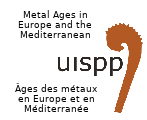This work describes the application of VIMP and Mott-Schottky (M-S) analysis of voltammetric and impedance data of sub-microsamples extracted from the corrosion patina of copper, bronze, and brass archaeological artifacts attached to graphite electrodes. Studied samples include Renaissance statues from the Hofkirche in Innsbruck and a variety of objects from Austrian museums and Archaeological Heritage Office (soprintendenza) in Italy, dating from the Copper Age to the 18th century. The theoretical approach developed exploits the semiconducting nature of cuprite and tenorite, the main copper corrosion products formed under ‘ordinary' atmospheric attack and moderate corrosion conditions.
Impedance measurements were carried out at sample-modified graphite electrodes in contact with 0.10 M Na2SO4 (pH 6.28) aqueous solution and plots of (capacitance)-2 vs. applied potential (Mott-Schottky plots) were obtained, whose slopes and intercepts can be related with the semiconducting properties of the metal patina in turn related to the composition, compaction, thickness, porosity, roughness and other textural features. The results obtained enable the classification of the studied archaeological samples, providing information on their composition, manufacturing technique, and age.
|
|
|
|
Combining electrochemical techniques for characterizing archaeological bronzes
1 : Universität Innsbruck
* : Corresponding author
|

 PDF version
PDF version
